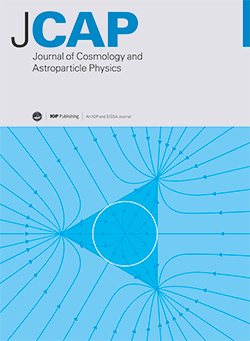Exploring Milky Way rotation curves with Gaia DR3: a comparison between ΛCDM, MOND, and general relativistic approaches
IF 5.3
2区 物理与天体物理
Q1 ASTRONOMY & ASTROPHYSICS
Journal of Cosmology and Astroparticle Physics
Pub Date : 2024-12-11
DOI:10.1088/1475-7516/2024/12/024
引用次数: 0
Abstract
With the release of Gaia DR3, we extend the comparison between dynamical models for the Milky Way rotation curve initiated in the previous work. Utilising astrometric and spectro-photometric data for 719143 young disc stars within |z| < 1 kpc and up to R ≃ 19 kpc, we investigate the accuracy of MOND and ΛCDM frameworks in addition to previously studied models, such as the classical one with a Navarro-Frenk-White dark matter halo and a general relativistic model. We find that all models, including MOND and ΛCDM, are statistically equivalent in representing the observed rotational velocities. However, ΛCDM, characterized by an Einasto density profile and cosmological constraints on its parameters, assigns more dark matter than the model featuring a Navarro-Frenk-White profile, with the virial mass estimated at 1.5–2.5 × 1012 M⊙ — a value significantly higher than recent literature estimates. Beyond 10–15 kpc, non-Newtonian/non-baryonic contributions to the rotation curve are found to become dominant for all models consistently. Our results suggest the need for further exploration into the role of General Relativity, dark matter, and alternative theories of gravitational dynamics in shaping Milky Way's rotation curve.用盖亚DR3探索银河系旋转曲线:ΛCDM、MOND和广义相对论方法的比较
随着Gaia DR3的发布,我们扩展了先前工作中开始的银河系旋转曲线动力学模型之间的比较。利用719143颗在|z| < 1 kpc和R≃19 kpc范围内的年轻盘状恒星的天体测量和光谱光度数据,我们研究了MOND和ΛCDM框架的准确性,以及先前研究的模型,如经典的Navarro-Frenk-White暗物质晕模型和广义相对论模型。我们发现所有的模型,包括MOND和ΛCDM,在表示观测到的旋转速度方面是统计等效的。然而,以Einasto密度曲线和宇宙学参数限制为特征的ΛCDM分配了比具有navarro - frank - white曲线的模型更多的暗物质,其维里质量估计为1.5-2.5 × 1012 M⊙,这一值显着高于最近的文献估计。在10 - 15kpc以上,非牛顿/非重子对旋转曲线的贡献在所有模型中始终占据主导地位。我们的研究结果表明,需要进一步探索广义相对论、暗物质和其他引力动力学理论在塑造银河系旋转曲线中的作用。
本文章由计算机程序翻译,如有差异,请以英文原文为准。
求助全文
约1分钟内获得全文
求助全文
来源期刊

Journal of Cosmology and Astroparticle Physics
地学天文-天文与天体物理
CiteScore
10.20
自引率
23.40%
发文量
632
审稿时长
1 months
期刊介绍:
Journal of Cosmology and Astroparticle Physics (JCAP) encompasses theoretical, observational and experimental areas as well as computation and simulation. The journal covers the latest developments in the theory of all fundamental interactions and their cosmological implications (e.g. M-theory and cosmology, brane cosmology). JCAP''s coverage also includes topics such as formation, dynamics and clustering of galaxies, pre-galactic star formation, x-ray astronomy, radio astronomy, gravitational lensing, active galactic nuclei, intergalactic and interstellar matter.
 求助内容:
求助内容: 应助结果提醒方式:
应助结果提醒方式:


